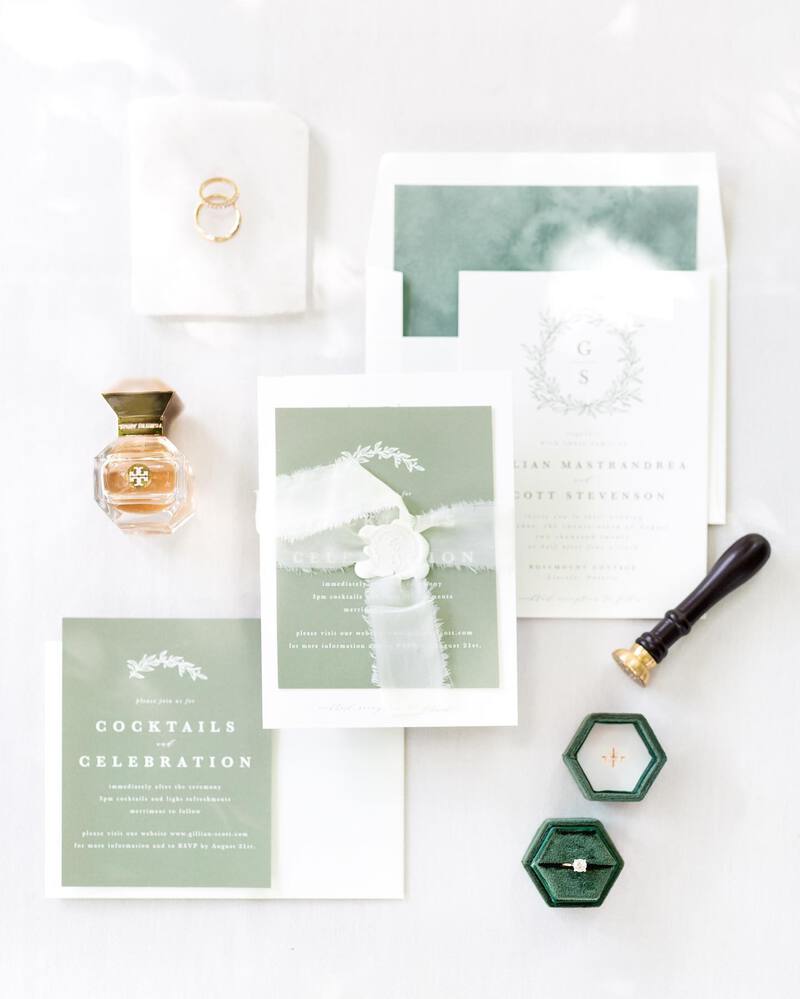Every wedding detail tells part of your story, starting with those carefully addressed envelopes landing in your guests' mailboxes. While deciding your wedding invitation wording, what wedding invitation design you’d like to use, and even your wedding RSVP card, you’re probably also considering exactly how to address your wedding invitation envelopes.
When addressing envelopes, there's a blend of traditional etiquette and modern considerations to keep in mind. In this article, we’ll dive into everything from when (and if!) you should use traditional titles, how to pluralize last names, and much, much more to help ensure that every invitation that lands in your guests’ mailboxes feels personal and welcoming.
Let’s get into it!
How to Address Wedding Invitation Envelopes
Wedding invitations can include an inner and outer envelope — the inner (which is optional) is usually only addressed with the names of the invitees while the outer envelope is the one that is stamped and addressed.
For the sake of this post, we’ll be focusing on how to address your outer, or mailing, envelopes.
How to Pluralize Last Names on Wedding Envelopes
Addressing envelopes to couples often involves pluralizing last names. While this may seem straightforward, there are specific rules you need to follow:
- Standard Last Names: For most last names, simply add "s" at the end. For example, The Smiths, The Johnsons, The Collins, The Wilsons.
- Names Ending in s, x, z, ch, or sh: For these special cases, add "es" to form the plural. For example, The Joneses, The Foxes, The Rodriguezes, The Lynches. The Welshes.
- Never add an apostrophe! This is one of the most common mistakes the wedding experts at Minted see in everything from envelope addressing to neon signs. Never use an apostrophe when making a last name plural, as it implies possession rather than a plural family name. These would all be incorrect: The Smith's, The Jones', The Rodriguez's.
Examples in Full Address Format
The Clarks
16 Maple Street
Portland, Oregon 97201
The Joneses
425 Park Avenue
New York, New York 10022
Maintain consistency in your pluralization throughout all wedding stationery, from save-the-dates to thank-you cards. This attention to detail is especially important when addressing invitations to married couples, as their shared last name often features prominently.
How to Address a Wedding Invitation to a Married Couple with the Same Last Name
Traditionally, the man’s full name is written out, with the titles of “Mr. and Mrs.” included. You can also opt to include both first names individually for a less traditional spin on how to address wedding invitations.
Here are a few common ways you can address a married couple with the same last name:
- Mr. and Mrs. Jackson Clarke
- Mr. Jackson Clarke and Mrs. Mary Clarke
- Jackson and Mary Clarke
This is the same for same-sex couples. Simply indicate the appropriate prefix in front of their names accordingly. For couples who use gender-neutral titles, the format remains the same.
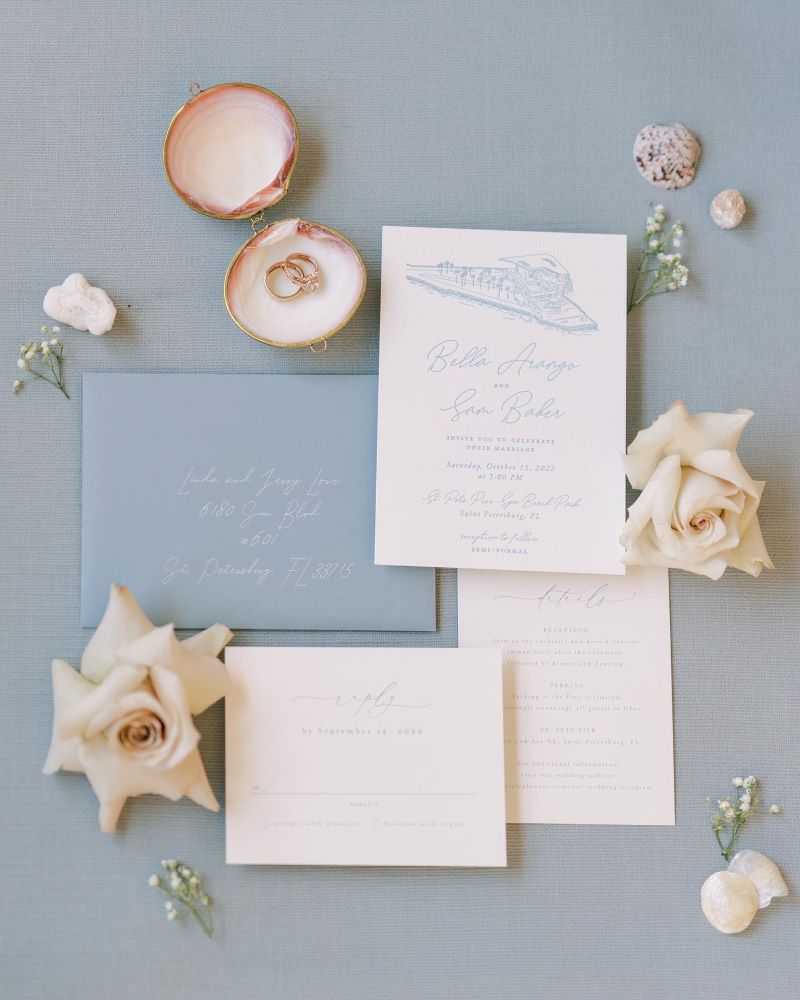
Photo by Matlock And Kelly Photography
How to Address a Wedding Invitation to a Married Couple with Different Last Names
For married couples with different last names, simply write out their full name with their preferred honorific on the stationery. You can list either partner first – the order isn't determined by gender identity or honorific. Choose based on your relationship with the couple or simply ask them their preference. Below are a few examples:
- Mrs. Gwyneth Brookes and Mr. Cyan Matthews
- Mr. Cyan Matthews and Mrs. Gwyneth Brookes
- Cyan Matthews and Gwyneth Brookes
- Mrs. Margarette Hyde and Mrs. Kayla Cruz
- Mx. Jordan Smith and Mx. Alex Johnson
How to Address a Wedding Invitation to an Unmarried Couple
For an unmarried couple that lives together, the full names of each guest should either be listed on one or two lines on the stationery, with their preferred honorifics placed. It’s best to open the starting line with the person you are closer to.
A few examples of what this might look like include…
- Ms. Alysson Schulz and Mr. Ricardo Gonzales
- Dr. Alysson Shulz and Mr. Ricardo Gonzales
- Mx. Jordan Smith and Mx. Alex Johnson
- Jordan Smith and Alex Johnson
Keep in mind that couples who don’t live together and aren’t married should receive separate invitations.
How to Address a Wedding Invitation to an Engaged Couple
It can be a bit tricky to know how to address wedding invitations to engaged couples. If you want to opt for a more formal route, it’s best to address both people as unmarried. However, if you want to be casual with it, you can lean into the idea of the couple being future newlyweds. Here are a few examples of both options:
- Mr. Luis Smith and Ms. May Hyde
- Mx. Jordan Smith and Mx. Alex Johnson
- The Future Mr. Luis Smith and Mrs. May Smith
- The Future Newlyweds, Jordan and Alex Smith
How to Address a Wedding Invitation to a Single Guest Who Gets a Plus One
For a single guest who gets to bring a plus one, it’s best to know the name of the person your invitee will bring (in which case, you can use the guidelines for couples we shared above). If not, simply include “& Guest” or “and guest,” following the full name and the preferred honorific of the invitee. For example, the address may look like…
- Mr. Tyler Morris & Guest
- Ms. Sarah Chen & Guest
- Mx. Jason Holt & Guest
- Matt Walker & Guest
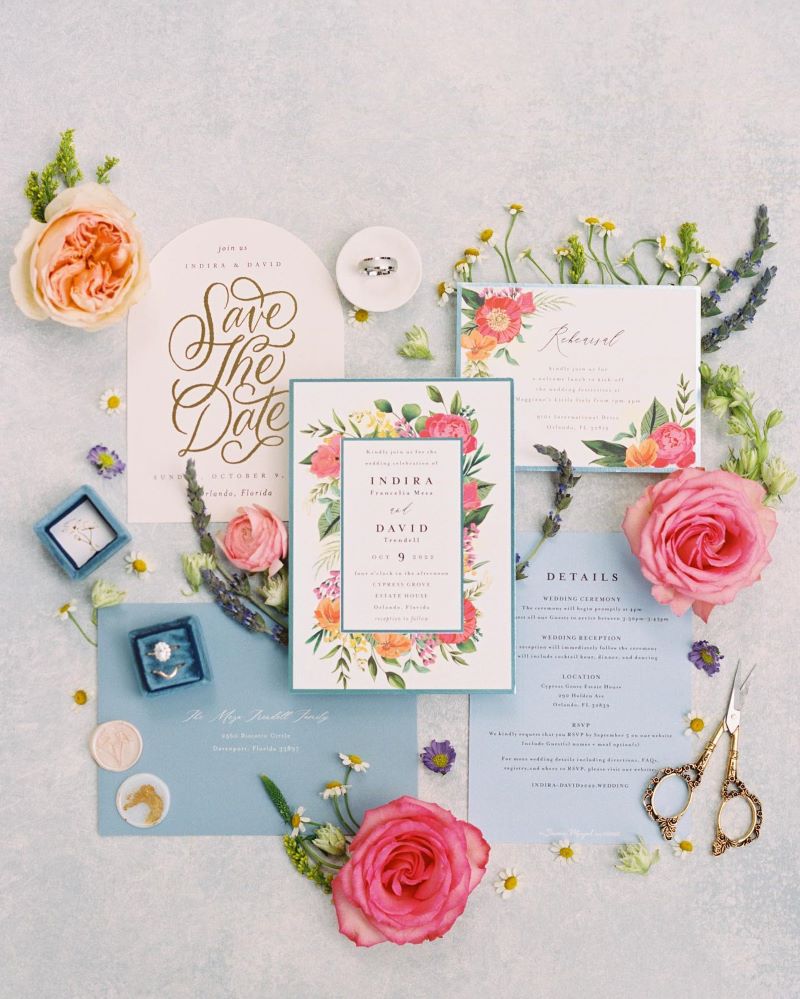
Photo by Autumn and Jendry
How to Address a Wedding Invitation to a Single Person
For single persons, whether male, female, or non-binary, the preferred honorific should be used in addressing your guests. Some may prefer traditional titles, while others might prefer gender-neutral options or no title at all.
- For male guests who prefer traditional titles, use "Mr." then their full name. For example, Mr. Alex Griffith
- For female guests who prefer traditional titles, use "Ms." then their full name. For example, Ms. Christie Leigh
- For guests who prefer gender-neutral titles, several options are available: Mx. Ryan Lowry or M. Ryan Lowry are both appropriate
- Some guests might prefer their name without any title. For example, Kevin Diaz
Keep in mind that some guests might use multiple honorifics or be particularly sensitive to honorifics (in the case of someone who is widowed or divorced, for example). In this case, simply ask them which they prefer for formal occasions like wedding invitations.
How to Address a Wedding Invitation to a Family
The way you address your invitation carries a lot of weight in communicating which members of a family are invited to your big day. If you’re inviting everyone, you can simply address the envelope to the whole family or include “& children” following the names of the married couple. For example,
- The Carter Family
- Mr. Max Carter and Mrs. Natasha Carter & Children
In contrast, if you want to be specific on which of the family members are invited, simply list down the names of the children (in order of birth) in separate lines after addressing their parents in the opening line. This could look like…
Mr. Max Carter and Mrs. Natasha Carter
Mx. Daniel Carter
Miss Alex Carter
Mr. Andrei Carter
400 Bluejay Way,
Bozeman, Montana 59715
Remember to use each family member's preferred honorific when listing them individually. Some may prefer traditional titles, others might choose gender-neutral options, and some might prefer no title at all.
How to Address Wedding Invitations to Those with Distinguished Titles
For those with distinguished titles, there are several ways these individuals can be addressed, married or not. When inviting two married doctors, the couple should be addressed as “The Doctors,” which can be spelled out or abbreviated. For example, “The Doctors Gabriel Roy and Alina Roy” and “Drs. Gabriel Roy and Alina Roy” are both appropriate ways to address an invitation.
For married couples where one of whom is a doctor, the order of addressing can vary depending on who is the doctor. Typically, the doctor goes first. So, an address could look like…
- Dr. Sophie Peterson and Mr. Tyrone Peterson
- Doctor Sophie Peterson and Mx. Karen Peterson
For other married couples with distinguished titles, the same rule applies. Whichever partner holds a “higher” title should typically be listed first. On the chance that the names would not fit the starting line, indent the following line.
How to Write Home Addresses on Wedding Invitation Envelopes
While getting your guests’ names and titles right is about etiquette, ensuring you properly format each guest’s home address is crucial to ensuring your invitations make it into their mailboxes.
Guests’ home addresses should be placed one line below their names. If you’re going for more formal invitations, be sure to avoid abbreviations. If not, abbreviations such as St., Rd., and CA (for California) should suffice.
Here’s an example of a formal address example:
Mr. John Corner and Mrs. Jenifer Corner
16 Faux Road
Fremont, California 94539
Here’s an example of a more casual address:
John and Jenifer Corner
16 Faux Rd
Fremont, CA 94539
Pro Tip: Minted provides free recipient addressing with each wedding invitation order. So, before you complete your order, be sure to collect any addresses that may be missing from your list, and double-check that all of your addresses are correct.
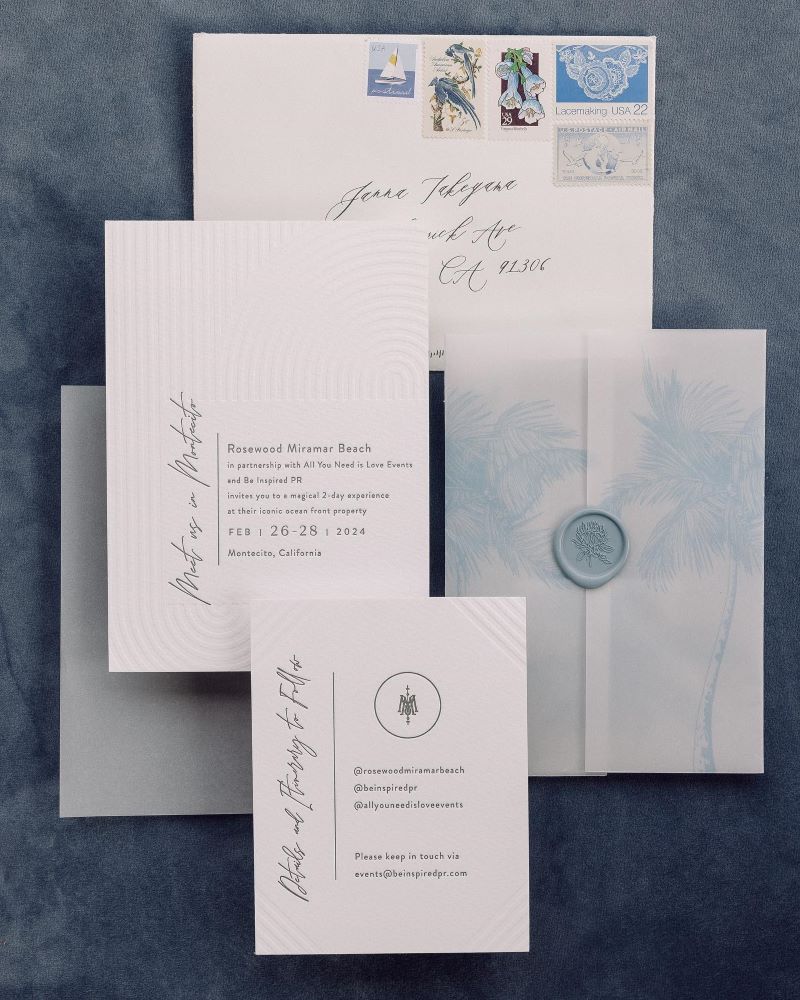
Photo by Josh Carr + Justin McGregor
Wedding Invitation Envelope Components, Accessories, and Finishing Touches
A wedding invitation isn’t simply a card within an envelope. There’s so much more to it than that. Depending on the type of wedding you’re going for, you can opt for a variety of different additions to complete your wedding invitation. While there isn’t a golden rule on what to and what not to include, understanding the different components can help you decide how you want your wedding invitation to be.
Minted offers different components and stationeries you would need to complete your wedding invitations. Whether you’re looking for invitations, outer envelopes, RSVP cards, wax seals, and other finishing touches like belly bands and ribbons, Minted can help you fulfill your dream wedding. Check out our wedding day stationery guide to make sure you haven't missed any essential pieces for your celebration.
Outer Envelope
Primarily used for mailing, the outer envelope includes the guest’s name(s) and address. The design of the outer envelope is complementary to the overall aesthetic of everything enclosed within as well as the wedding itself.
Inner Envelope
With the main purpose of keeping your invitation pristine from the post office, more often than not, inner envelopes are no longer needed due to proper handling of the outer envelope by automated readers. Placed inside the outer envelope, this envelope includes all other enclosures along with the main invitation.
If you do opt to use an inner envelope, the guests’ should also be addressed here as well. Typically, you can drop the street address and simply list names with or without titles, depending on your preference:
Traditional formal outer envelope:
Mr. James Bennett and Mrs. Sarah Bennett
123 Park Avenue
New York, New York 10022
More informal inner envelope:
Mr. and Mrs. Bennett
or
James and Sarah
For couples using gender-neutral titles, you can follow the same pattern:
Formal outer envelope:
Mx. Jordan Smith and Mx. Alex Smith
456 Main Street
Boston, Massachusetts 02108
More informal inner envelope:
The Smiths
or
Jordan and Alex
Wedding invitation address printing
Don’t feel like you need to block off a weekend to tackle addressing each of your envelopes by hand! Minted's wedding invitations include envelopes and custom addressing with our unique styles and fonts to match.
Wax seals and stickers
Wax seals and custom stickers are a beautiful way to elevate your wedding invitation envelopes. Wax seals leave a unique imprint that can elevate the feel of the invitation while custom stickers give the invitation a smooth finish without the need for additional postage.
Wedding invitation RSVP cards
RSVP cards are essential to confirm the number of guests present at your wedding. These cards can be included separately or indicated on the main invite, and should always come pre-addressed with your home address, or the address of where you’d like them to be returned to (such as your wedding planner or maid of honor, for example).
Additional postage
Opting for the use of wax seals or including multiple enclosure cards within your invitation suite will most definitely require the use of additional postage. Make sure to check with your local post office to inquire about the size and any other fees before finally sending out your wedding invites.
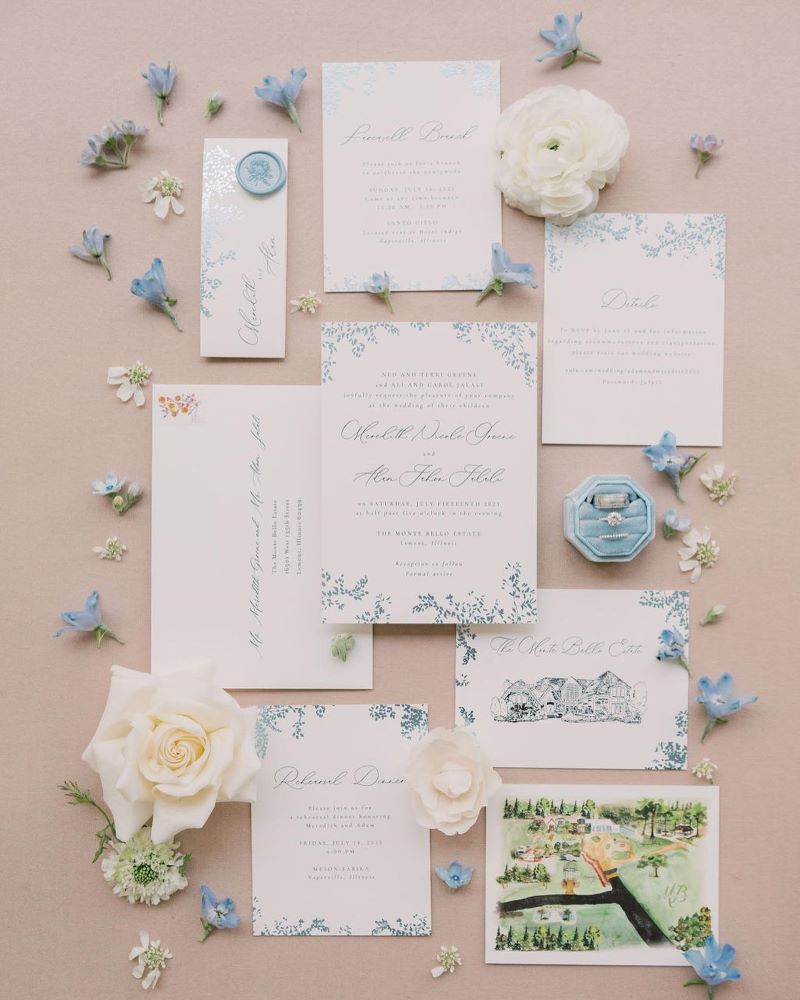
Photo by Bon Photage Fine Art Photography
Wedding Invitation Addressing FAQs
How do you address envelopes for an 18+ wedding?
If you’re not inviting children to your wedding, you’ll want to make this clear to your guests. This includes for either the ceremony itself and the rehearsal dinner, as well. You can include this on the main invitation or the RSVP card.
Nevertheless, you probably won’t want to just include the line, “No kids allowed.” Instead, you can try:
“Please note that this occasion is adults-only.”
or
“This will be an adults-only celebration.”
Do you have to address your wedding invites by hand?
Handwriting the invitation addresses is optional. While it can be a very thoughtful touch, it can add a lot of work and more room for error. Luckily, digital calligraphy is gaining popularity as it emulates a similar feeling to handwritten invites without the stress and time it takes to do it. All of Minted’s wedding invitations come with free recipient addressing in a wide range of font styles to match the vibe of your big day.
How should you order guests’ names on wedding invitation envelopes?
Traditionally, men are listed first. That said, you don’t have to follow tradition if you don’t want to! We usually recommend that you list the person that you’re closest with first, or you can arrange them alphabetically if you’re equally close with both invitees.
Do you have to put Mr. and Mrs. on wedding invitations and envelopes?
Not at all! While traditional titles like "Mr." and "Mrs." are still beloved by many couples, modern wedding etiquette has evolved to embrace all kinds of honorifics and preferences. You might have guests who prefer gender-neutral titles like "Mx." or "M.," others who use professional titles like "Dr.," and some who'd rather skip titles altogether and just use their names.
The most important thing is addressing your guests in a way that makes them feel welcomed and respected. Whether you're going for a formal wedding where titles feel right, or a casual celebration where you'd rather use first names only, there's no wrong choice. Some couples even mix it up, using titles for formal elements like outer envelopes while keeping inner envelopes more casual.
If you're unsure about someone's preferences, it's perfectly fine to ask! Your guests will appreciate your thoughtfulness in wanting to address them correctly.
What if you're not sure of someone's current title or marital status?
When in doubt, it's perfectly acceptable to contact the guest directly or ask a family member who might know. It's better to verify than to make assumptions that might lead to addressing errors (and hurt feelings!).
How should you handle return addresses on wedding invitations?
Traditionally, return addresses go on the back flap of the outer envelope. They can be printed in the same font as the front or in a complementary style. Be sure to include a return address even if using hand-canceling to ensure any undeliverable invitations are returned.
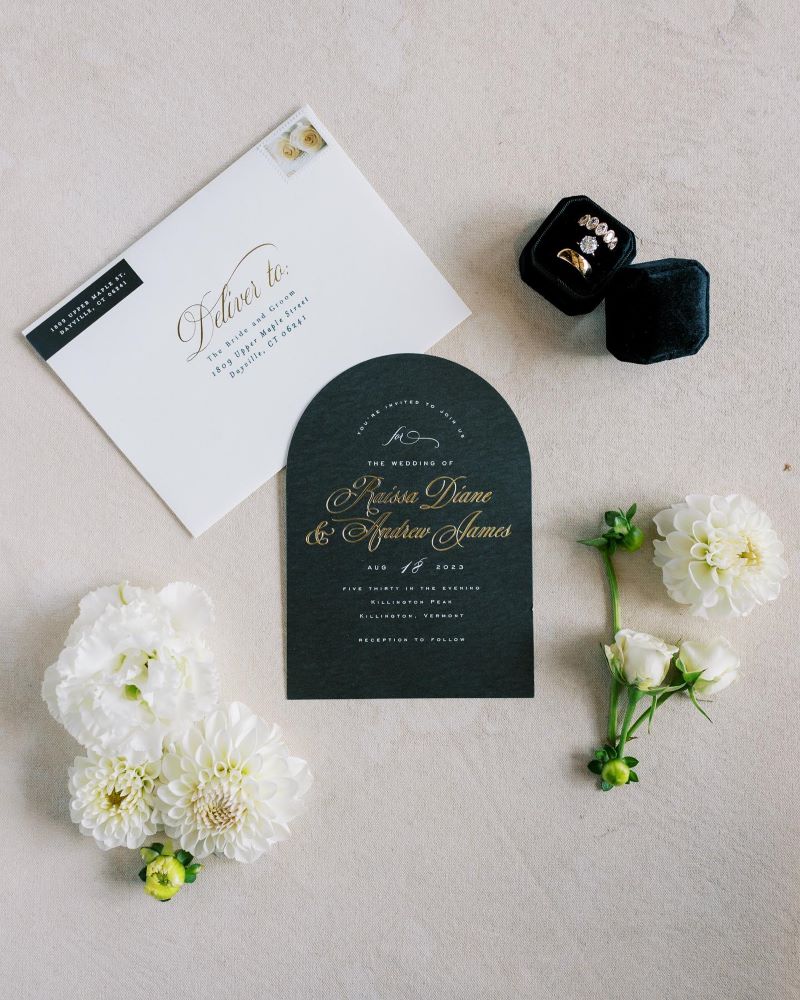
Photo by Coryn Kiefer Photography
Complete Your Wedding Invitations with Minted
As you prepare to send your beautifully addressed invitations, remember that selecting the right size envelope is a detail that shouldn’t be overlooked. Whether you choose classic A-style envelopes or elegant Euro-flaps, Minted offers a range of options to match your wedding's aesthetic. The most common size for wedding invitations is the A7 envelope (5.25" x 7.25"), perfect for our popular "classic 5" x 7" invitations. For your RSVP cards, enclosure cards, and thank you notes, we recommend the A2 size (4.375" x 5.75"). Take a quick look at our invitation size guide to ensure a perfect fit!
In addition to having the perfect envelope to pair with your elegant letterpress invitations or unique save the dates, Minted makes it easy to ensure each one arrives beautifully addressed. All wedding stationery orders come with free custom addressing in your choice of beautiful fonts and styles.
Ready to create your perfect wedding invitations? Get a Free Consultation with Our Expert to help bring your vision to life.





